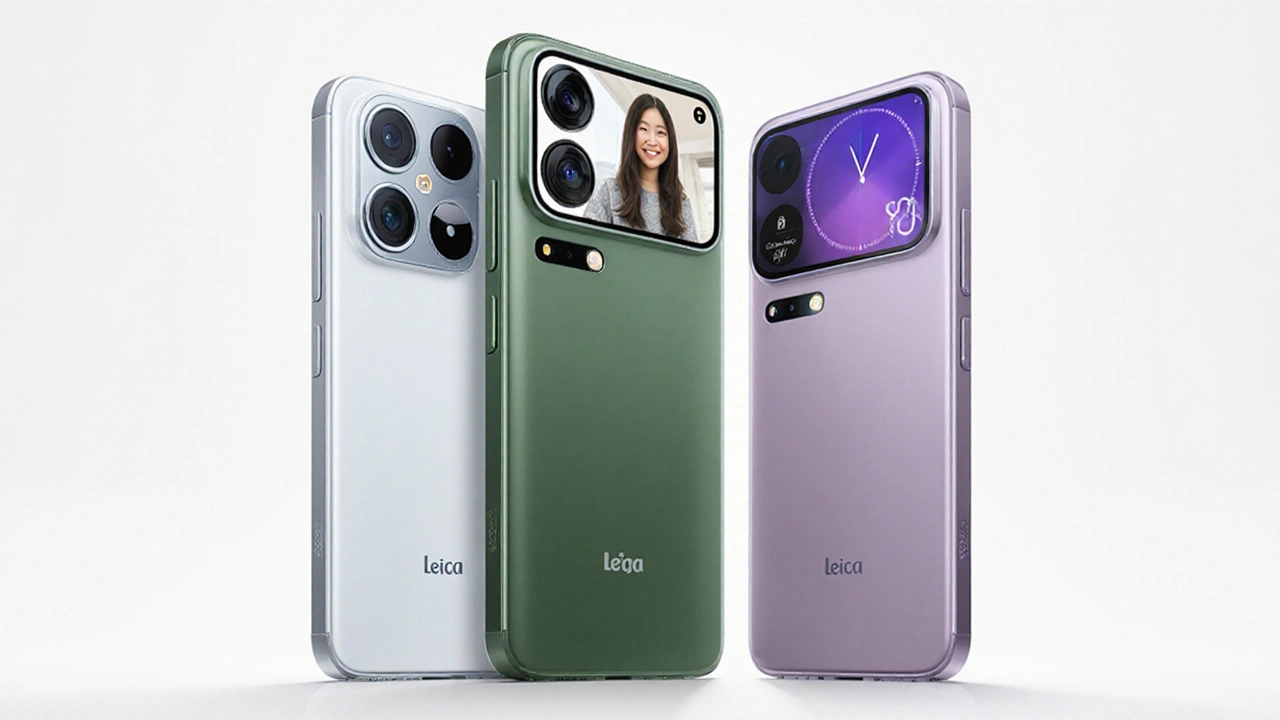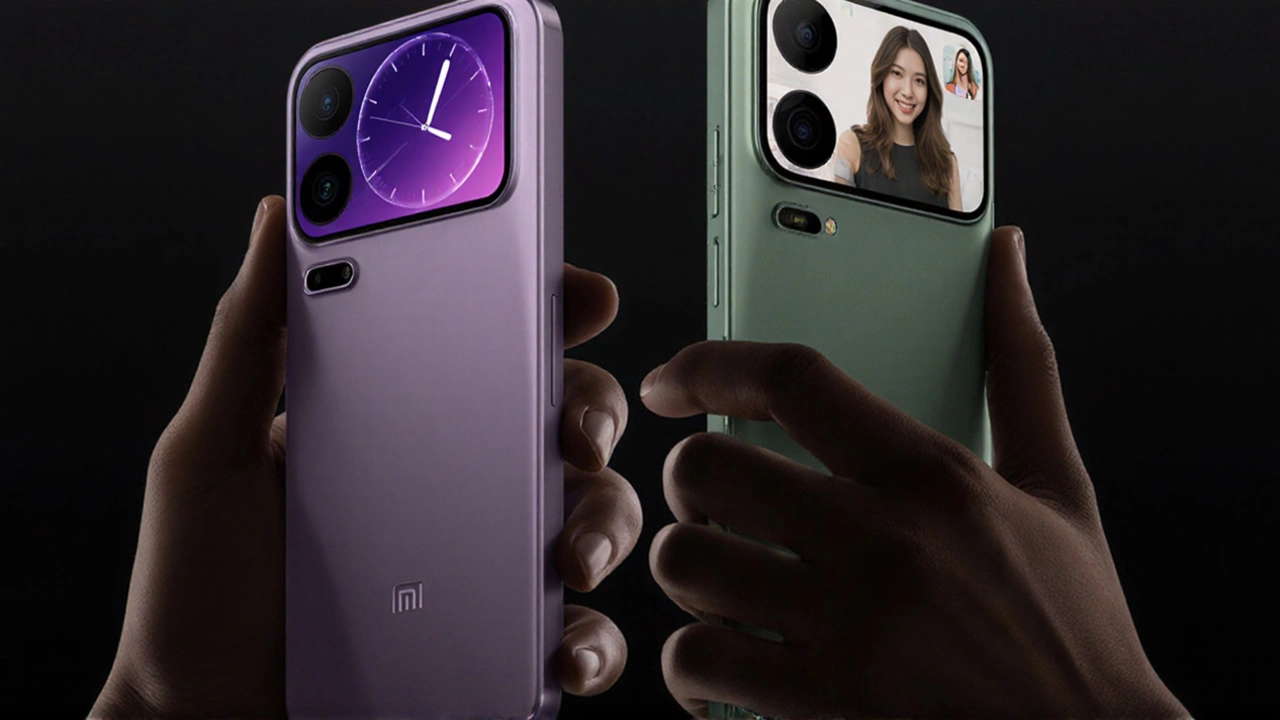The buzz around the Xiaomi 17 Pro Max isn’t just about another flagship chip. It’s about a literal second screen on the back of the phone—a 2.66‑inch AMOLED panel that feels like a nod to classic handheld consoles. Xiaomi markets it as a game‑changer for selfies, multitasking, and mobile gaming, but the reality is a mix of excitement and caution.
How the rear display changes the smartphone experience
First off, the rear screen isn’t a gimmick. It acts as a live viewfinder for the triple 50 MP Leica camera system. When you line up a group shot or a selfie, the back panel shows exactly what the main lenses see, so you can adjust composition without holding the phone awkwardly. In practice, this means fewer “oops, I’m out of frame” moments and smoother burst shooting.
Beyond photos, the extra screen opens a sandbox for multitasking. Imagine keeping a Discord chat, a game walkthrough, or a music equaliser on the back while the primary 6.9‑inch LTPO AMOLED displays the game itself. It mirrors the Nintendo DS’s dual‑screen workflow, which sold over 150 million units because users loved having dedicated space for maps or inventories.
The Snapdragon 8 Gen 5 processor powers both displays without a noticeable lag, and the 7,500 mAh battery—paired with 100 W wired charging—tries to keep the phone alive even when both screens are lit. Early benchmarks suggest the main screen can stay at 120 Hz while the rear panel runs at a modest 60 Hz, preserving battery life where possible.
- Camera advantage: instant framing and exposure preview.
- Gaming boost: separate controls, maps, or streaming overlays.
- Productivity lift: quick notes, shortcuts, or secondary apps without cluttering the main view.

Practical hurdles: durability, battery, and app support
All that tech comes with a price tag—mainly in the form of practical drawbacks. An exposed screen on the back means the glass is constantly rubbing against tables, pockets, and keys. Even with hardened Gorilla Glass, the risk of scratches or cracks is higher than on a front‑only device that usually lives inside a case.
Battery consumption is another knotty issue. Running two displays draws more power, and while the 7,500 mAh cell is generous, real‑world tests show a noticeable dip in screen‑on time when both panels are active. Users may find themselves toggling the rear screen off for most of the day to stretch the battery.
Then there’s the software ecosystem. Developers need to specifically design UI elements for the back panel; otherwise, the screen sits idle. So far, only a handful of gaming titles and a few productivity apps have announced dual‑screen support. Without broader adoption, the rear display could end up as a novelty rather than a daily tool.
To mitigate durability concerns, Xiaomi is already teasing rugged cases that frame the rear glass with metal ribs and a raised lip. These accessories could help, but they add bulk—a trade‑off many users might not be willing to make.
Ultimately, the success of the Xiaomi 17 Pro Max hinges on whether the added functionality outweighs the extra care the phone demands. If the company can lock down a solid developer kit and convince popular apps to embrace the second screen, the device could carve a niche for power users and mobile gamers. If not, the rear display may remain a bold experiment that looks great on paper but struggles to find a steady spot in everyday pockets.


 Sports
Sports
Purna Chandra
September 27, 2025 AT 03:54When you first lay eyes on the Xiaomi 17 Pro Max’s rear panel, you’re hit with a flash of ostentatious ambition – a secondary AMOLED that looks like it was stolen from a boutique gaming console. The design swagger is undeniable, yet it reeks of a gadget‑obsessed elite who believes more glass equals better status. In practice, the rear screen does serve as a live viewfinder for that triple‑lens Leica rig, sparing you the awkward selfie gymnastics. It also promises a dual‑screen workflow reminiscent of the Nintendo DS, which, let’s face it, still haunts our collective nostalgia. However, the notion that this gimmick will seamlessly integrate into daily life feels like a pipe‑dream concocted by marketing alchemists. The glass, even with Gorilla‑Guard, will sigh under the friction of pockets and keys, turning into a liability faster than you can say “premium”. Battery‑drain is another sacrificial lamb; two displays guzzle power despite the 7,500 mAh behemoth. So while the concept dazzles in showroom lighting, the real world will likely expose its fragility and superfluousness. In short, it’s a bold experiment that may never graduate from novelty to necessity.
Mohamed Rafi Mohamed Ansari
October 6, 2025 AT 03:54While I appreciate the technical depth of the dual‑screen approach, it is essential to acknowledge the limited app ecosystem currently supporting such functionality. The lack of widespread developer adoption may render the secondary display underused.
अभिषेख भदौरिया
October 15, 2025 AT 03:54In contemplating the rear screen, one might ponder the broader philosophical question of what constitutes true utility in our handheld companions. The device, though engineered with intricate precision, simultaneously offers a canvas for contemplation and a mirror reflecting our desire for perpetual novelty. If we accept that technology should augment, not distract, perhaps there lies a subtle equilibrium to be found between spectacle and substance. Yet, the reality of everyday use-jostling in pockets, the inevitable scrape of surfaces-reminds us that elegance is often a veneer upon pragmatic concerns. Ultimately, the screen may serve as a metaphor for our own split attentions: the desire to capture the moment versus the necessity to live within it.
Nathan Ryu
October 24, 2025 AT 03:54From a moral standpoint, glorifying a device that demands extra care borders on irresponsibility. Users deserve transparency about the wear‑and‑tear ramifications rather than polished hype.
Atul Zalavadiya
November 2, 2025 AT 02:54Let us dissect the myriad implications of integrating a secondary AMOLED panel on the rear chassis of a flagship smartphone, an endeavor that straddles the line between audacious innovation and ostentatious excess. Firstly, the rear display functions as a dedicated viewfinder, granting photographers an unparalleled composition tool that eliminates the awkward arm‑extension ritual typically associated with high‑resolution shooters. This, in turn, accelerates workflow efficiency, especially in dynamic environments where split‑second framing decisions dictate success. Moreover, developers who seize this opportunity can craft bespoke UI layers, enabling real‑time telemetry for competitive gamers-a feature that could tilt the balance in fast‑paced titles where map awareness and inventory management are paramount. On the productivity frontier, imagine orchestrating a multitasking tableau: a transcription app scrolling on the back while drafting an email on the primary screen, thereby compartmentalizing cognitive load. However, it is incumbent upon us to recognize the inherent trade‑offs: the dual‑screen architecture inexorably inflates power consumption, compelling the battery to discharge at an accelerated cadence despite the generous 7,500 mAh reservoir. Thermal dissipation also becomes a concern, as the Snapdragon 8 Gen 5 must allocate resources to sustain two active displays without throttling performance. From a durability perspective, the external glass, even fortified with hardened Gorilla‑Glass, remains vulnerable to abrasive contact, necessitating protective accessories that may compromise ergonomics and aesthetic purity. The ecosystem’s readiness is another pivotal factor; absent broad developer endorsement, the rear panel risks languishing as an ornamental afterthought rather than a functional asset. In summation, while the concept bespeaks a visionary stride toward reimagining mobile interaction, its ultimate viability hinges upon judicious software support, robust hardware safeguards, and a user base willing to accommodate the attendant compromises.
Amol Rane
November 11, 2025 AT 02:54Honestly, the whole rear‑screen hype feels like a pretentious fad; unless every app gets a makeover, it’s just a pricey vanity piece.
Venkatesh nayak
November 20, 2025 AT 02:54Looks cool 😎
rao saddam
November 29, 2025 AT 02:54Wow!!! This is exactly what the market needed???!!! Over‑engineered yet undeniably alluring!!!